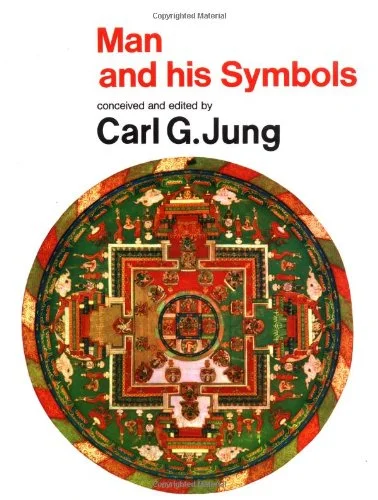| Title | Man and His Symbols |
| Author | Carl Jung |
| Year | 1968 |
| Publisher | Dell |
| Pages | 432 |
| Rating | ★★★★★ |
| Purchase Link | Buy Here |
“Man and His Symbols” is a book organized by Carl Jung, the Swiss psychiatrist and founder of analytical psychology.
It was published in 1961 and was his last work alive. It was based on a series of works made by Jung and his associates towards the end of his life.
Today, we’ll learn a little about this classic book about Psychology. To read other psychology book summaries, click here.
Synopsis of Man and His Symbols
This book is probably one of Carl Jung’s most famous books (which is interesting, since the book is written by many people), and can be a very nice introduction to his school of thought:
Man and his Symbols discusses the concept of the collective unconscious, which is a part of the psyche shared by all humans and contains archetypes, or universal symbols and themes that are present in the myths, legends, and religious traditions of all cultures.
Understanding these archetypes can help us better understand ourselves and our place in the world.
The book also covers a range of topics including dream analysis, the psychology of religion, and the psychological aspects of artistic creativity, and is intended for a general audience. To buy Man and His Symbols, click here.
Summary of Man and his Symbols
The book was published in the 60’s, based on a series of materials that Jung and his associates wrote towards the end of his life.
In the book, Jung explains the presence of the archetypes in our subconscious, and how it is present in arts, myths and religions. Jung explains how we can use it to understand our world and find our place within it.
As the book is a collection of lectures, it might be considered a little less cohesive than his other works. However, it is possible to understand its main points.
Chapter 1
The chapter begins explaining the concept of subconscious, which is our part of the mind that understands things without the need of rational thinking. The author details its importance and examples of it, and how we can better understand it.
Chapter 2
The author explains there has always been a symbolism behind old legends and myths, and that man still uses it to localize himself in the world.
Chapter 3
In the third chapter, Jung explains that a person develops his individuality as time passes by. The chapter contains many Jungian concepts, like shadow, anima and others.
Chapter 4
The author shows that the plastic arts, like sculpture, painting, etc. have some symbolic meaning beyond the work’s rational explanation.
Chapter 5
It is possible to do a self-analysis using Jungian techniques to search for your own improvement. This chapter details important points on that.
Chapter 6
This chapter shows how many scientific discoveries corroborate the Jungian techniques and lessons.
Review of Man and his Symbols
So, what to think about the book? I’ll try to explain a little:
Overall, “Man and His Symbols” is a thought-provoking and insightful examination of the psychological and spiritual aspects of human experience. It offers a unique perspective on the human psyche and the role of the unconscious mind in shaping human behavior and experience.
Despite some criticisms of the book’s lack of empirical evidence and its focus on Jung’s own ideas, it remains an important and influential work in the field of psychology.
Jung influenced many people with this book, and whether you’re a psychology scholar or just a person that likes to read about it, you should give it a try.
It is written in a popular style, intended for a general audience, and is considered one of Jung’s most accessible works. To buy Man and His Symbols, click here.
Key Lessons
The book presents many important lessons, such as:
- The collective unconscious is a part of the psyche shared by all humans and contains archetypes, or universal symbols and themes that are present in the myths, legends, and religious traditions of all cultures.
- Understanding these archetypes can help us better understand ourselves and our place in the world.
- Dream analysis can provide insight into the unconscious mind and help individuals understand their own psychological processes.
- The psychology of religion is a valuable field of study that can help us understand the psychological motivations behind religious beliefs and practices.
- Artistic creativity has psychological roots and can be understood through an examination of the unconscious mind.
- Jung’s ideas are relevant to the modern world and can provide valuable insight into the psychological and spiritual aspects of human experience.
Another classic psychology book is Man’s Search for Meaning, so click here to check a review about this great work!
Negative Points of Man and his Symbols
Some possible criticisms of the book could include:
- Some readers may find Jung’s ideas difficult to understand or conceptualize.
- The concept of the collective unconscious and the existence of archetypes are not universally accepted in the field of psychology, and some readers may be skeptical of these ideas.
- This work is more symbolic in its nature, and some readers may prefer a more scientific approach to psychological concepts.
- The book’s focus on the unconscious mind and the spiritual dimensions of human experience may not appeal to readers who are more interested in more practical or secular approaches to psychology.
- The work focuses on Jungian ideas and theories, which may be seen as limiting its scope and ignoring other important perspectives in the field of psychology.
Positive Points of Man and his Symbols
Here are some positive points that could be made about “Man and His Symbols” by Carl Jung:
- The book is a comprehensive overview of Jungian ideas and their relevance to the modern world.
- It offers a thought-provoking and insightful examination of the psychological and spiritual aspects of human experience.
- The concept of the collective unconscious and the archetypes it contains provide a unique perspective on the human psyche and can offer valuable insights into the psychological motivations behind human behavior and experience.
- The book’s discussion of dream analysis, the psychology of religion, and the psychological aspects of artistic creativity provide valuable insights into these areas of study.
- The book is written in a popular style and is intended for a general audience, making it accessible to readers who may not have a background in psychology.
Should you read Man and his Symbols?
So, is the book a good take on psychology for someone that wants to read a book about it? Sure!
Man and his Symbols is one of the most classical works about Jungian psychology. It’s a great introduction to Jung’s ideas, despite being a little complex sometimes. However, it’s definitely recommended both for psychology students and for casual readers.
If you want to read it, you should check it out! To buy Man and His Symbols, click here.

